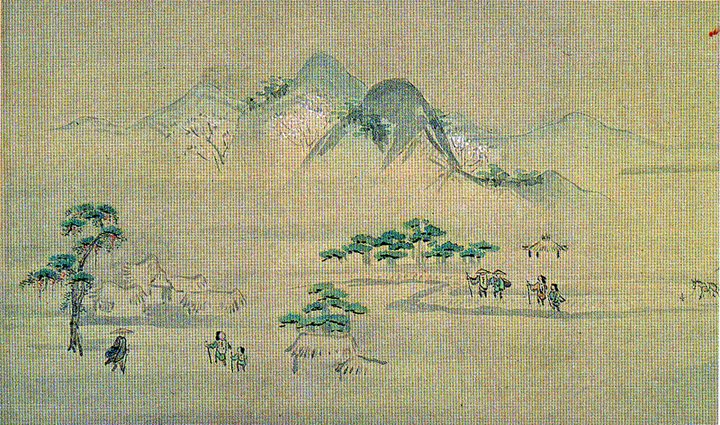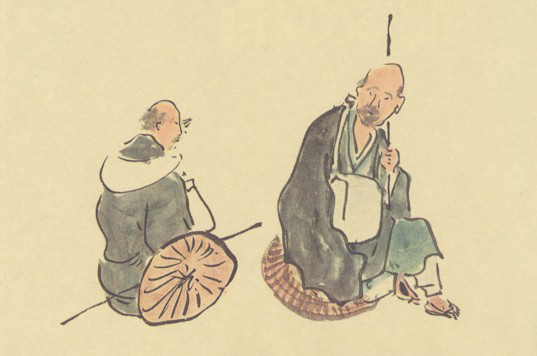Oku no Hosomichi
Oku no hosomichi (Jap. .奥 の 細道, dt " On narrow paths to the hinterland ") is a travel diary and one of the most famous works of Japanese poet Matsuo Basho. Oku here means both hinterland / Peripherals / very remote from the capital - in the form of the then northernmost and most remote province of Mutsu (also Michinoku ) - as well as his own inner. Originated the work is in a rough draft in 1689, the first edition was in 1702 ( Kyôto ).
Diary of a Journey
Oku no hosomichi owes its existence to a travel basho in late spring 1689, he and his traveling companion Kawai Sora (* 1649 - † 1710). Consummated on March 27, 1689 ( Genroku 2 Nen Japanese calendar) of Edo (now Tokyo ) made in the northern hinterland, Oku. Overall, the trip lasted 156 days. Basho traveled on foot.
Basho and Sora walked northbound along the Pacific coast, about Nikko, Sendai, Matsushima ( Miyagi ) and Hiraizumi, then through the central mountains to the shore of the Sea of Japan by Sakata. From Sakata from the traveling companions took a detour to the now-defunct Bay Kisagata, the northernmost point of the trip. This was followed by Basho and Sora the shore of the Japan Sea along the south, first back to Sagata and on over Niigata, Kanazawa and Fukui to the Bay of Tsuruga and from there inland over Ôkagi, where he met some of his students, according to Yamanaka. The last part of the journey across Honshu to return to Edo put Basho left alone. The length of travel distance was about 2,400 km.
With his journey Basho joined the tradition of the wandering poet - priest as Saigyo. Like its predecessors, will also visit Basho places that are the subject of poetic admiration since time immemorial. The Japanese language has this expression uta makura - "Poem pillow ". The diary as a whole follows the literary form of Renga, it scatters scenes with high emotional content between more objective- informative parts. The text is a mixture of prose and poetry, and contains numerous references to Confucius, ancient Chinese poet and Saigyo such as Li Po. It is committed to the aesthetic concept of the Sabi. Primarily, the book is a travelogue in which Basho performs lively and poetic content of his travel stations. Basho visited the Tokugawa shrine in Nikko, the Shirakawa barrier, the islands of Matsushima, Sakata, Kisakata and the province Etchu.
After the end of his journey Basho spent five years, the poems (especially haiku ) and to revise the text of Oku no hosomichi before he finally published.
" Uta makura " in Oku no hosomichi
Uta makura (Japanese歌 枕) or " poem pillows " are places or attractions that are the subject of admiring poems are traditional, so are particularly suitable as a subject of a poem.
The best-known poems to Basho's " uta makura " from the Oku no hosomichi are:
- Edo:
Kusa no to mo sumi- kawaru yo zo hina no ie.
"I will leave the house in which I lived alone so far. Perhaps a happy and big family is here once live. "
- Nikko
Aratou to aoba wakaba no hi no hikari.
"How solemn it when the Tōshō - gū the sun's rays reflected that play on the fresh green leaves is. " ( Nikko offers a famous sight., Where there is a large Shinto shrine, is buried in the Ieyasu Tokugawa shogunate, the was founded by Edo. )
- Ogaki
Hamaguri Futami no ni yuku aki zo wakare.
" I depart from this my close people like a shell that opens up in this sad autumn. " ( Ogaki meant the end of the trip. Basho separated by some close to him. He made his funeral a poem in which he grief with which aufteilenden mussel compares. )
- Mogami River
Zemindars where atsumete hayashi Mogamigawa.
The torrent of Mogami River has collected from the early summer rain plenty of water. (Japanese rivers are considered fluent faster than European and American. The Mogami is literally tearing. )
- Gassan
Kumo no mine ikutsu kuzurete Tsuki no yama.
" The cloud covered the summit of Gassan, blew away. The moon shines beautifully on the Gassan. " ( " Gassan "means moon mountain. )
- Sado Island
Araumi ya Sado ni yokotou Amanogawa.
The sea is rough! And the great Milky Way sprayed on the island of Sado. ( From the island of Sado from Basho had a beautiful view of the Sea of Japan. )
Matsushima
Matsushima ( Pine Islands) belongs to the traditional three most beautiful landscapes of Japan. In the Matsushima Bay, there are several hundred of pine -lined small islands - it is a " Uta makura " par excellence. Basho himself dedicates this destination no haiku, but only a prose section, but can be found in Oku no hosomichi a haiku of Sora, the Matsushima has to content:
Matsushima ya tsuru ni mi where kare hototogisu
Bay of Islands pine, lend you the shape of the crane, thou mountain cuckoo!
Hiraizumi: Memories of Yoshitsune
The most famous haiku from the Oku no hosomichi, and one of the most famous haiku ever arose in Hiraizumi, where one of the greatest tragic hero of Japan, Minamoto no Yoshitsune, was found in a legendary battle to the death. Basho passes the haiku with the following words:
" Because the remains of the residence of the Yasuhira and his followers were ... The faithful vassals [ Yoshitsune ] had entrenched themselves there - oh, the reputation of its glories was short-lived by dense undergrowth all tracks are overgrown ' The land is. . devastated - mountains and rivers but are intact - greens over ruins when the bilge comes only grass'! -. These poem words went through my head with my bamboo hat spread under me, I sat there, shedding tears - and forgot the time. "
When watching the grassy landscape, where the tradition has taken place after the battle, Basho composed the following haiku:
夏草 や 兵 ども が 夢 の 跡
Natsugusa ya tsuwamonodomo ga yume no ato
Summer grass is the last track of the dreams of the Warrior
Summer grass ...! of all the dreams of glory the last trace
The word summer grass frequently encountered in Haiku, reference is made to the current season ( season word - kigo ). The central part of the haiku is dominated by the sechsilbigen word archaic word tsuwamonodomo (warrior ), which gives the poem a special gravitas. Basho leaves, of which the warriors who lost their lives on this battlefield, may have dreamed of ( the victory of fame - as Dombrady assumes in his translation of safe homecoming? ). After Dombrady comes in the poem, especially the " illusionistic dream existence of man in this world," expressed.


.jpg)





